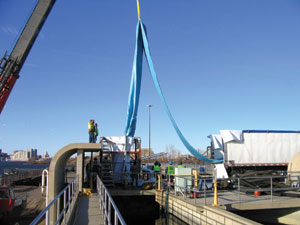Rehabilitation Runner Up
October 1, 2008
 To keep infrastructure working properly year after year, it must be regularly maintained and often rehabbed to continue working at its peak level — which was the case at the Camden County, N.J., Water Treatment Plant Outfall System.
To keep infrastructure working properly year after year, it must be regularly maintained and often rehabbed to continue working at its peak level — which was the case at the Camden County, N.J., Water Treatment Plant Outfall System. Two parallel, 60-in. outfall pipes designated to discharge treated wastewater from the plant into the Delaware River, had begun to leak badly. These pipes, which stretch 320 ft from the plant to the river, had received some attention and point repairs in the past but had degenerated to the point an emergency repair was necessary. Camden County Municipal Utility Authority (CCMUA) called for bids in order to rehabilitate the lines immediately.
The work was awarded to Insituform Technologies Inc. which also worked with consultants from Greeley and Hansen LLC in nearby Philadelphia. Together, the two companies were tasked with designing a project that would respond to the variety of obstacles anticipated, such as time constraints, location and structural concerns.
“There were a set of conditions and requirements we just hadn’t seen all in one project before,” said Jay Lovelass, project manager for Greeley and Hansen.
Because of the severity of the leaks, the lines first needed to be sealed off before beginning work on the pipes. Elaborate groundwater dewatering was conducted beforehand. Since the plant could only be shut down for 72 hours at a time, crews had to coordinate their work with the plant’s operators and a specific plant schedule.
Access to the pipes was an issue. The only access point crews had to the lines was through a chlorine contact chamber and a sluice gate. The location of the access point required the team to examine a handful of the structures at the water treatment plant to ensure they could support the weight of the equipment and vehicles needed for the project. In addition to the tough access points, the crews occasionally had to work under the riverbed throughout the project.
Since the project required work in the Delaware River, the water itself presented its own set of challenges. First, an inflatable plug was used to seal the river outlets to keep water out of the discharge ends of the pipes. Secondly, the work schedule was affected again and needed to coordinate with the tides to avoid high-water periods.
Next, the actual structures of the rehabilitated lines were addressed. The plant’s outfall system posed problems for the crew. The pipes — located on twin square outfall box culverts that were constructed in 1987 in order to connect to the existing twin, 60-in round concrete outfall pipelines that were part of the previous treatment plant built in the 1940s — create a system of back-to-back S curves that included two 90-degree bends. With the square box culverts being connected to the round pipelines, crews had to pay close attention to avoid wrinkling in the liner. To properly address the square box culverts, a subcontractor was called in to spray the inside of those sections with gunite to shape them into round pipes, Insituform officials say.
“The various shapes, bends and sizes of the outfalls were an especially unique aspect of the project,” says Lovelass. “Rehabilitating them required some very innovative technology and techniques by Insituform and the rest of the team.”
After designing the project around unique circumstances and working strict schedules crews completed the rehabilitation of the outfall pipes in June 2008.
Pam Stask is an assistant editor of Trenchless Technology.
Project Owner: Camden County Municipal Utility Authority (CCMUA)
Engineer: Andy Kricun, CCMUA chief engineer and deputy executive director; Greeley and Hansen
Contractor: Insituform Technologies Inc.
